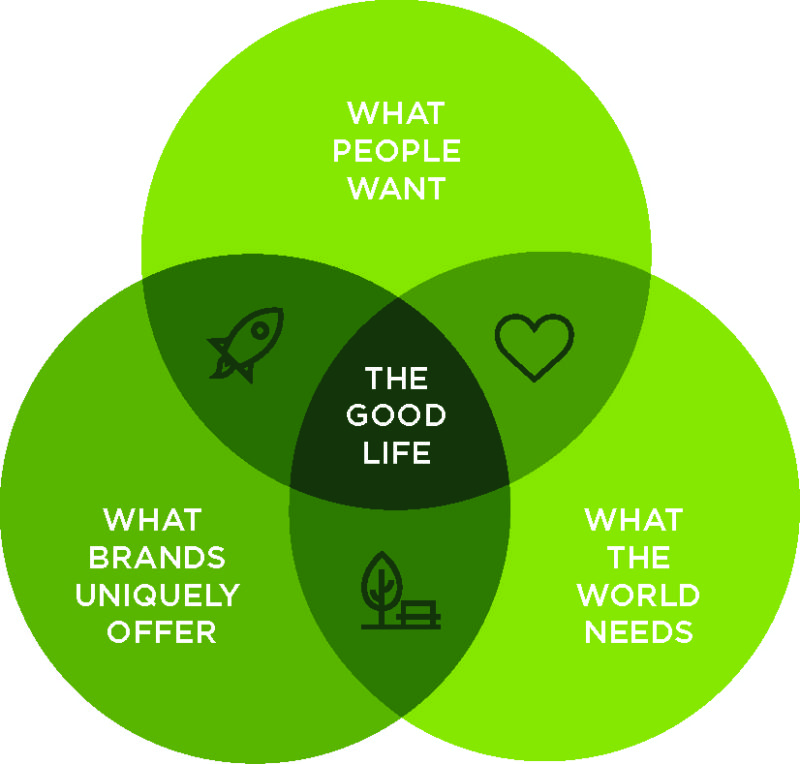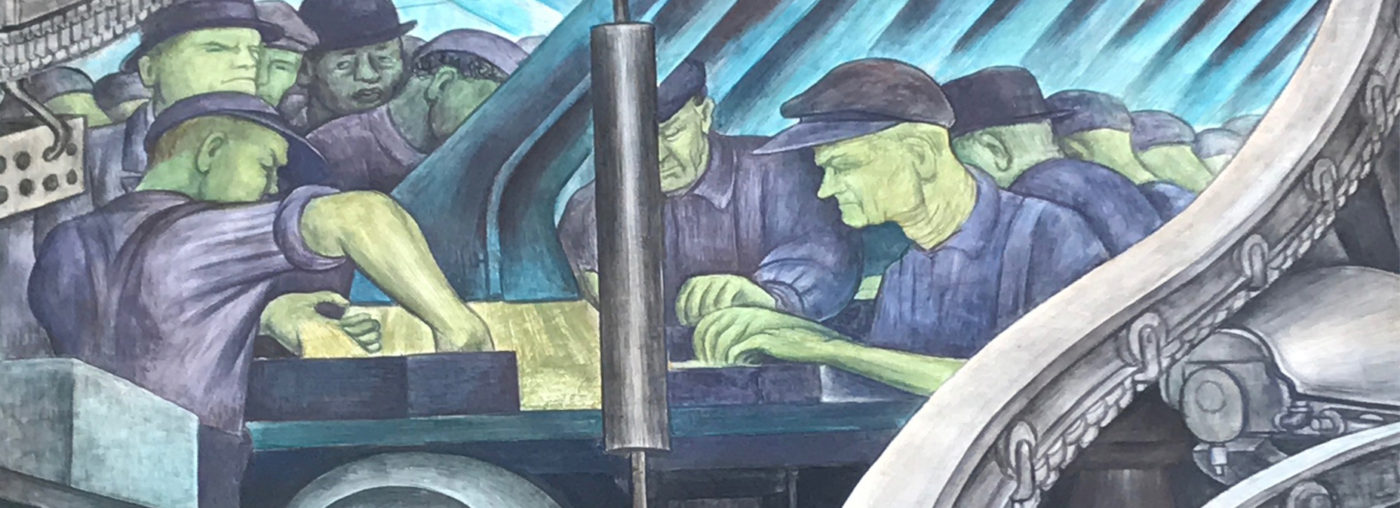This piece highlights the most inspiring insights Laura and Candon learned while attending the twelfth annual Sustainable Brands (SB) conference. This conference was more of a call to action than a typical event urging a broad swath of global brands and sustainable leaders and their community to address urgent environmental imperatives, rather than preserving a pattern of business-as-usual. The theme for this year’s conference, “Delivering the Good Life” embodies how consumers are shifting away from money, status, and personal achievement to find balance, simplicity, and personal connection in the world of retail. Arguably, one of our most significant national civic rebirths is happening Detroit. This chosen location formed the perfect backdrop for like-minded practitioners to focus on co-creating a greener economy through interactive work sessions aligned with circularity, regeneration, and collaboration.

Circularity
Inspiring a Desire + Demand for a Circular Economy
Circularity for this audience means that celebrated brands are making a systemic change, at every scale, where their products or services contribute to environmental and societal benefits. Creating value and prosperity through products or services that leverage reused, re-manufactured, recycled materials, or provide an essential source of energy.
Target’s Lisa Boyd on Living their Values
- Responsible Consumerism is one of our corporate goals
- All employees learn “Circular Design Principles.”
- Waste reduction efforts are tackling packaging and production
- New product launches are strategic and focused on building a powerful sustainability voice
- New featured products include “Good and Gather” grocery brand and Everspring natural cleaning products
- Target is hosting a national car seat takeback program
- They are advocating green practices with their partners related to green chemical management and recycled content in products
- Target is investing in research programs focused on textile recycling and green chemistry
Carmen Gama Shares Eileen Fisher’s Bold Sustainability Commitments
- Start with design “Design out negative impacts and design in positive change.”
- 100% organic cotton and linen by 2020
- Reducing water use (Bluesign standard) and carbon footprint
- Create takeback programs for used garments where customers return clothing for store credit. Gently used clothes can be cleaned, repaired, and then sold in “renew” stores. Damaged items are recycled into new fibers for new designs.
- A percentage of profits go into programs that support environmental health, human rights, and advocacy for women and girls.

Plastic Recovery-Land and Sea (PRLS) initiative with Bill McDonough
- Focuses on reducing and preventing ocean plastics pollution at the source and creating valuable materials.
- Our previous mantra of “reduce, reuse, recycle also needs to add Recover.”
- Recovered plastic is a resource, and many companies such as Dow, Unifi, Dell, and HP are looking for recovered plastic to recycle.
Driving Behavior Change and a Cultural Shift with Interactive Content
Heroic “Aha” Moments from the Panel
- Reaching people through advertising and art. Real engagement happens by merging personal experience and active learning.
- Asher Jay, with National Geographic, is tackling endangered species treatment through community education.
- Leveraging, VR, art, graphics, design, and other media allows storytellers to present new perspectives and evoke empathy.

Regeneration
Anatomy of Effective Sustainability leaders
This lively panel focused on the vital leadership qualities brands need to embrace to build a sustainable business.
- Collaboration is paramount. Bring more people, ideas, and data into the conversation. Unlikely coalitions can have an impact.
- Leverage the power of storytelling and share positive outcomes.
- Emphasize the scientific and strategic imperatives of sustainable business.
- Emotive writing skills are essential when it comes to shaping a narrative that can influence outcomes.
The Pull Factor and Drive Impact: Factory Workshops
- These two sessions outlined how consumers are looking for meaning over materials, passion over career goals, happiness over homeownership, and more. Brands must stand for more than just a product.
- During the 45-minute workshop, participants created effective ad campaigns for the “conscious consumer” solely based on sustainable product features.
- Panelists from Ben & Jerry’s and Walgreens gave examples of how campaigns charged with a cause have a notable impact. Examples included Red Nose Day and Pecan Resist.
- All participants and representatives rallied around their advocacy and call to sustainability to maintain a thriving business moving beyond business as usual.
Scaling the Living Building Challenge: How Big Brands are Leveraging Regenerative Principles to Transform Real Estate Portfolios
- Andreas Gyr, Google’s Sustainability Program Manager, provided an in-depth tour of the Bayview and Charlestown East campuses. Bayview is targeting LBC certification for water, beauty, and place. Charlestown East is targeting a full Living Building Challenge certification. Google’s water reduction metrics are impressive and include onsite water treatment and water export to neighbors on a district scale.
- Jake Arlein of Stok, a sustainable real estate services firm, discussed the importance of creating an action plan for every project. The project plan must include an emotive why statement, philosophy, vision, mission, and aligned goals and values. The question to ask yourself is, “What does good look like to us?”

Collaboration
Tips for How to Engage People on Your Sustainability Adventure
Convert the daunting task of driving change into having fun; this workshop offered ideas on how to move groups of people forward.
- Build consensus by creating goals that focus on Motivation, Innovation, and Commonality.
- Leverage training, eco-design tools, and the “gamification” of tasks to empower people to contribute.
- LUSH Cosmetics described how their Stewardship Committee created an open platform for sharing ideas at all levels of the business.
- Empower people that have a passion for the cause yields unexpected, successful solutions.
- Show consumers they don’t have to give something up by choosing a sustainable option.
Girl Approved New Advertising
Heidi Dangelmeier, the founder of Girlapproved, partnered with Axe Body Spray, historically seen as sexist and outdated, to widen their consumer base.
Heidi and her team engaged hundreds of young men to determine what they are looking for in their hair and body products. The feedback clearly showed that men were seeking education, instruction, and clear packaging with their products. The resulting campaign, Axe Hair, demonstrates how men can create a desired persona with their products. Instructions and icons related to hair type and how-tos are now an integral part of the packaging.
Not only does this partnership and effort address chemicals, construction, and consumers, it also discusses how the world is changing.
The Change Generation
- Millennials and Generation Z are the “Change Generation,” and brands need to respond to their needs to maintain their business.
- Purpose matters to this group, and purpose-driven brands are twice as likely to be successful. They do their research and share it on social, so authenticity is no longer a choice.
- These generations demand to see change, live their lives in a sustainable way, and seek professions that are engaged in sustainable practices. They have a choice and empower their community to use it.

Noteworthy Takeaways
- Sustainability is not exclusively about the physical environment; it is about the people, processes, and business. How we work and play together, emphasizing collaboration and partnerships, will determine our success.
- Communication and engagement must involve everyone – our collective success and ability to innovate depends on overlapping, diverse perspectives.
- Sustainability is not exclusively about the physical environment; it is about the people, processes, and business.
- This work can be daunting. Celebrating success through emotive stories creates a ripple effect and inspires new projects.

